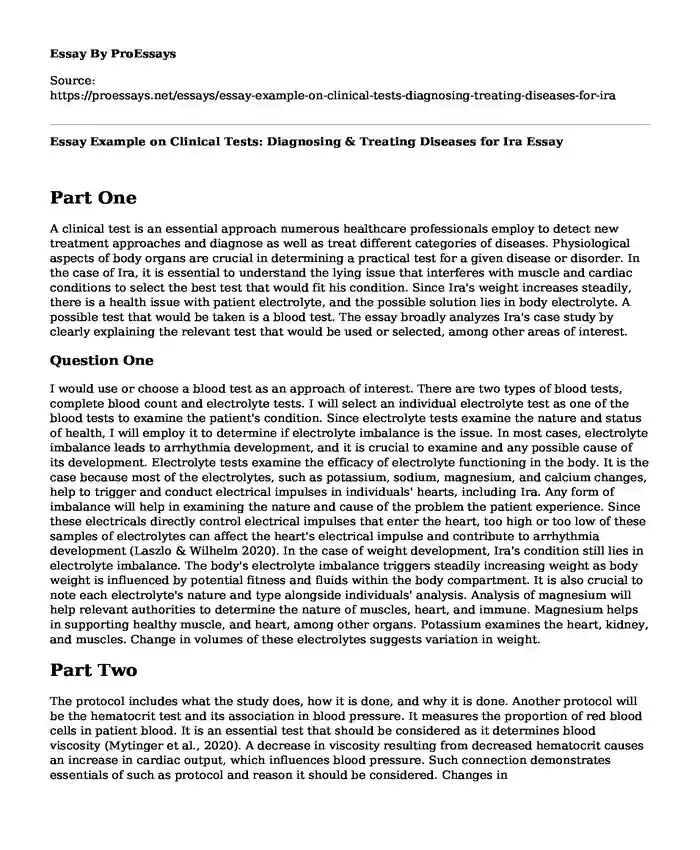Part One
A clinical test is an essential approach numerous healthcare professionals employ to detect new treatment approaches and diagnose as well as treat different categories of diseases. Physiological aspects of body organs are crucial in determining a practical test for a given disease or disorder. In the case of Ira, it is essential to understand the lying issue that interferes with muscle and cardiac conditions to select the best test that would fit his condition. Since Ira's weight increases steadily, there is a health issue with patient electrolyte, and the possible solution lies in body electrolyte. A possible test that would be taken is a blood test. The essay broadly analyzes Ira's case study by clearly explaining the relevant test that would be used or selected, among other areas of interest.
Question One
I would use or choose a blood test as an approach of interest. There are two types of blood tests, complete blood count and electrolyte tests. I will select an individual electrolyte test as one of the blood tests to examine the patient's condition. Since electrolyte tests examine the nature and status of health, I will employ it to determine if electrolyte imbalance is the issue. In most cases, electrolyte imbalance leads to arrhythmia development, and it is crucial to examine and any possible cause of its development. Electrolyte tests examine the efficacy of electrolyte functioning in the body. It is the case because most of the electrolytes, such as potassium, sodium, magnesium, and calcium changes, help to trigger and conduct electrical impulses in individuals' hearts, including Ira. Any form of imbalance will help in examining the nature and cause of the problem the patient experience. Since these electricals directly control electrical impulses that enter the heart, too high or too low of these samples of electrolytes can affect the heart's electrical impulse and contribute to arrhythmia development (Laszlo & Wilhelm 2020). In the case of weight development, Ira's condition still lies in electrolyte imbalance. The body's electrolyte imbalance triggers steadily increasing weight as body weight is influenced by potential fitness and fluids within the body compartment. It is also crucial to note each electrolyte's nature and type alongside individuals' analysis. Analysis of magnesium will help relevant authorities to determine the nature of muscles, heart, and immune. Magnesium helps in supporting healthy muscle, and heart, among other organs. Potassium examines the heart, kidney, and muscles. Change in volumes of these electrolytes suggests variation in weight.
Part Two
The protocol includes what the study does, how it is done, and why it is done. Another protocol will be the hematocrit test and its association in blood pressure. It measures the proportion of red blood cells in patient blood. It is an essential test that should be considered as it determines blood viscosity (Mytinger et al., 2020). A decrease in viscosity resulting from decreased hematocrit causes an increase in cardiac output, which influences blood pressure. Such connection demonstrates essentials of such as protocol and reason it should be considered. Changes in
Question Two
Appropriate exercise protocol for a standard part includes aerobic, strength, and warming up and cooling down. The exercise should take three days per week, with 50 minutes daily. They should exercise fifty minutes a day with the first fifteen minutes of warming up, twenty-five minutes of the main exercise targeting the heart, and ten minutes of cooling down. At each stage of the training, the different practices should be considered. Warming up should include pulse-raising activities such as low-level cycling, matching on the spot, stretching muscles. I would also recommend individuals to perform free machine exercises. Machines exercises work best at individuals and focus on one part of the body at a time. I suggest individuals use heart rates to measure the intensity of their activities.
References
Laszlo, R., & Wilhelm, M. (2020). Exercise in Specific Diseases: Atrial Fibrillation. In Textbook of Sports and Exercise Cardiology (pp. 1029-1044). Springer, Cham. https://link.springer.com/chapter/10.1007/978-3-030-35374-2_49
Mytinger, M., Nelson, R. K., & Zuhl, M. (2020). Exercise Prescription Guidelines for Cardiovascular Disease Patients in the Absence of a Baseline Stress Test. Journal of Cardiovascular Development and Disease, 7(2), 15. https://www.mdpi.com/2308-3425/7/2/15
Cite this page
Essay Example on Clinical Tests: Diagnosing & Treating Diseases for Ira. (2023, Sep 14). Retrieved from https://proessays.net/essays/essay-example-on-clinical-tests-diagnosing-treating-diseases-for-ira
If you are the original author of this essay and no longer wish to have it published on the ProEssays website, please click below to request its removal:
- Paper Example on Child Development
- Management Systems Approach to Health and Safety Essay
- Nutritional Requirements of Individuals - Essay Sample
- Abortion in the US: Divisive, Controversial, and Impacting Society - Essay Sample
- Nutrition Plan for Athletic Male: Liam Case Study
- Essay Sample on Prompt Response to OSHA Citations & Penalties
- Disseminated Intravascular Coagulation - Free Essay







